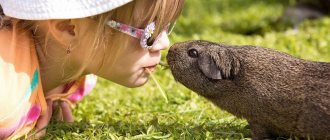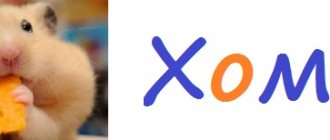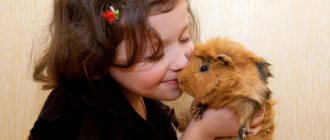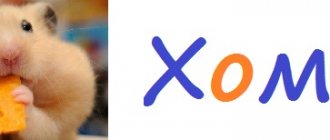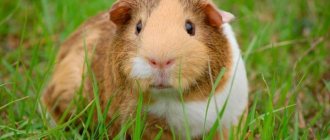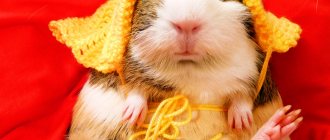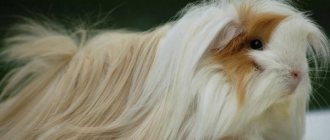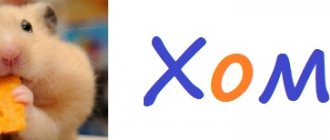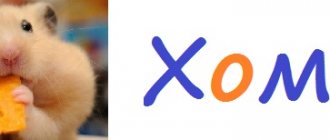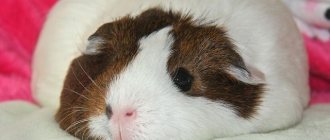Guinea pigs have long been popular pets. These cute rodents are easy to purchase in pet stores or at the Bird Market. However, the animals sold there are often outbred (crossbred) because they do not have any documents confirming their origin. Of course, this will not prevent the pig from becoming a pet, but if you plan to engage in serious breeding of these animals, then such a “breeding breeder” can please you with an unpredictably diverse offspring. For breeding, you should purchase purebred pigs of known origin. Today there are a number of clubs for guinea pig lovers that coordinate the activities of breeders and organize exhibitions. In these clubs you can purchase young animals of different breeds with pedigrees. The choice of breeds is quite large: from the already familiar smooth shorthaired, Peruvian and Abyssinian, to a variety of rare and exotic ones (curly Texels, crested Cresteds, etc.). In general, today there are more than 80 breeds of guinea pigs, differing in the structure, length and color of their coat, and thanks to the work of breeders, more and more new ones are appearing. The most popular marine breeds will be discussed in this article.
There are various classifications of guinea pig breeds in the literature. One of the most common classifications is the division of guinea pigs into three large groups - long-haired, short-haired and rare. Modern breeders also use the following option for dividing into groups:
- English Self - guinea pigs of solid color (solid color)
- Long Hair non Selfs - (Sheltie, Peruvian, Coronet, Texel, Alpaca, Merino)
- Short-haired (woolen) (Coated, non Selfs) - (agouti, American and English Cresteds, Abyssinians, Rexes, etc.).
- Rare Varieties are so-called new breeds that are still quite rare.
The range of colors in guinea pigs is also very diverse; they can be completely monochromatic (white, black, buff, red, chocolate), agoute (natural color), variegated, two or three colors, and even Dalmatians.
Guinea pigs with long hair
Peruvian
Peruvians are the pioneers of these cute, long-haired animals. Selection for their breeding began already in the 1800s in Europe. The long, thin fur of pets falls on the sides and on the head. Therefore, if the pig is not a show pig, the “bangs” can be trimmed, otherwise they can be tied up or pinned. Breed standards require only a straight coat, without curls, and two rosettes - on the rump and head, near the nose. Their character is much calmer than that of other representatives; they can sit on their hands for a long time.
Sheltie and Coronet
Shelties can rightfully be considered the most pleasant to the touch. Compared to the Peruvian, the silky representatives do not have a parting on the back, the fur falls back. True shelties should not have any rosettes, and the covering on the head is much thicker, creating a kind of mane. Like many long-haired guinea pigs, they also have a calm temperament. But Coronets are rightfully the most active among the longhaired ones. They are distinguished by a single rosette on the head, the glossy long fur from which falls beautifully on the sides without covering the face. Pets that do not participate in exhibitions are usually cut into a bob so that the coat does not become dirty. It took much longer to produce modern Coronets than the breeds described above. To understand for yourself which guinea pig is the best of the breeds with such a hairstyle, you should pay attention to the character. The most peaceful and slow are Peruvians and Shelties, the most active and playful are Coronet. But the latter can also sometimes be in a phlegmatic mood.
On the left - Peruvian, in the middle - Sheltie, on the right - Coronet
Coronet
The Coronet came from the Crested and the Sheltie. The result is a breed with a very unusual coat: there is a rosette crown on the head, and there are partings along the back in different directions. The impression is as if an invisible hand is constantly combing the rodent.
Coronets are affectionate, kind, and very trusting. They willingly make friends with children and allow themselves not only to be stroked, but also to experiment with their fur.
The fluffiest of fluffies
Rex
Rex is considered one of the newly developed breeds. They should not have rosettes; the hair on the head is usually coarser than on the back and sides. Due to the nature of the Rex guinea pig's coat, they sometimes need to be brushed with a special brush. Interestingly, this is one of the most intelligent breeds that can be trained. They need the company of their relatives more than others.
American Teddy
This breed is also one of the fluffiest and largest. They can be identified by their drooping ears and predominantly coarse coat.
The thickest wool is Alpaca
The Alpaca breed has a very thick, long, curly coat. They were bred back in the 19th century in South America. The main external differences are that there are several rosettes on the muzzle and the back of the body, and the growth of the cover on the legs from bottom to top. Alpacas are very friendly even towards strangers and have a calm character.
Left - Rex, middle - Teddy, right - Alpaca
Sheltie
At first glance, Shelties are very similar to Peruvians. But the fur is combed back. This is a distinctive feature of these animals. At first glance, it is noticeable that these are purebred guinea pigs.
When purchasing this beautiful pet, you need to be prepared for the fact that children will not be able to care for it on their own due to its long fur coat. But shelties are very attractive for games, especially for girls who give them original hairstyles.
The largest guinea pig is Kui
Not just the largest guinea pig, but a real giant - on average, they are twice as large as usual, weighing about 3.5 kilograms. In their homeland, Peru, Kuevs are bred mainly for meat, like our large breeds of rabbits. But more and more often they can be found as pets. Kui differ from their relatives in their more aggressive disposition towards each other and towards humans. Therefore, they are kept one at a time. If a person takes a very small cub, he can still make it tame. But the habit of biting remains with all giant piggies, with rare exceptions. Most Cuis have polydacty - 5 and 6 toes on the hind and front paws. The animals themselves do not suffer from this in any way. Due to the characteristics of the body, in particular the tendency to obesity, the life expectancy of guinea pigs at home is an order of magnitude lower - only 3 years.
Natural enemies of skinny
Photo: What skinny looks like
Skinnies have no natural enemies, as they are domestic animals. Skinnies are more vulnerable to elements and factors that cause their health to deteriorate. They are sensitive to low and high temperatures. They should be placed in a room with normal room temperature. Feeding skinnies properly and placing them in a moderate temperature room allows them to maintain a normal body temperature.
Because they lack hair, they are more vulnerable to injury, infection, and skin lacerations. Skinnies with exposed skin should be handled with care as they are extremely vulnerable to injury and infection. Therefore, as a necessary precaution, they should be stored indoors in a controlled environment. They should be introduced to sunlight, but from then on, their playful and curious nature must be monitored. They may end up causing injury to their delicate bodies.
Their most significant difference is that skinnies must be kept indoors. Due to their lack of fur, they have trouble maintaining body heat when they are in cooler environments. They also do not cope well with drafts. Skinny bedding should be soft and free of sharp objects and surfaces. They are truly sensitive and any minor vulnerability they encounter must be addressed to ensure their overall safety.
Smooth fur and smooth skin
Representatives of smooth skins
Baldwin guinea pigs are completely hairless and have smooth skin. Skinny has fur on his nose and paws, from birth to the end of his life. The main features of care are compliance with the temperature regime and a more varied diet (the diet should be higher in calories than that of other pigs). Read more about smooth guinea pigs in the article Baldwin Guinea Pig.
Left - Skinny, right - Baldwin
Self breed guinea pig
The Self breed has English roots and dates back to the 1920s. These are representatives with short hair, a relatively compact build, and a color in which only one color predominates. Moreover, even the ears, eyes and paw pads must match the color of the coat. Cute selfies can be both calm and active. Their advantage is the lack of aggressiveness even in a pair of males. A good option for a purebred animal for those who are thinking about which guinea pig is best for the home.
Agouti
Agouti is almost the ancestor of all guinea pigs. At the same time, there is a type of Agouti color that is characteristic of other breeds. The main feature of the color is the ticking. At the base of the hair, almost at the skin, the hair has one color, in the middle it turns into a second color, the tips have a third shade, most often darker. Ticking is present everywhere, even on the paws. Agoutis are also highly trainable.
Crested
The American Crested is so called because of the rosettes on the top of its head that are colored white. They are also called crested guinea pigs. The animal itself has short, smooth fur, without any partings. Crested dogs do not have any pronounced character traits; they live well with almost any kind of piggyback, and they are also favorable towards humans.
Nutrition
Long-haired pigs are herbivores, so the food should be predominantly plant-based; the following combination is considered optimal:
- grass or hay – 60-65%;
- juicy food – 30%;
- dry food – 5%.
It is best to purchase hay in a specialized store, in which case you can be sure that it will be of adequate quality. When buying at the market from hand, you may encounter irresponsible sellers who did not remove poisonous herbs when preparing feed or collected food near highways and large industrial facilities.
The food requirement of a shaggy guinea pig is 150 g per day. You can give her dill, parsley, lettuce; pigs love strawberries, pears and cherries; they will not refuse vegetables, they especially love carrots, cabbage or zucchini.
Try to keep your pet's diet as varied as possible; the body should receive a full range of vitamins, macro- and microelements. If your pet eats only cabbage or carrots, this will have the most unfavorable effect on its overall well-being.
The ideal situation would be when the rodent’s daily diet contains at least 3 types of vegetables and juicy greens. As the latter, you can take leaves of strawberries, raspberries, black and red currants; carrot and beet tops are very useful for animals.
We pay special attention to the fact that the rodent requires table salt, so you will need to buy a salt stone. Unfortunately, with other products the pet will not be able to receive the required amount of salt, while it is very important for normalizing the digestion process
The animal should not be hungry - if it does not receive food for more than 18 hours, irreversible pathological changes are triggered in the body, which can cause the death of the rodent.
As for supplementary feeding, here you need to focus on the juiciness of the main feed. If your pig gets enough fluids from her food, she may not drink water at all. On average, an adult pet needs 60-70 ml of water per day. Few people know, but the rodent body is not able to absorb vitamins B and K during the very first passage of food, so many animals often eat their own feces, since when they pass through the digestive organs again, all substances are absorbed in full.
All in rosettes - Abyssinian
It is very easy to distinguish Abyssinians - they are completely in rosettes, the hair is not very long, about 3-4 centimeters. This coat does not require additional care. There should be eight rosettes, evenly distributed throughout the body. Abyssinians have a more active character and are big fans of running. They are friendly towards the owner, but they get into fights with their relatives much more often.
Himalayan
The Himalayan albino pig has a unique genetic coat color: a snow-white shade with a dark characteristic spot in the nose area. Another amazing feature: the absence of eye pigment, which makes the pupils appear red, although in fact only the blood vessels that create such an unusual color are visible. The ears have an unusual petal-shaped shape. The hair is hard, dense and thick. As the air temperature decreases, its tone changes somewhat towards a darker side. These rodents are afraid of sunlight, so when choosing a place for the cage, take this feature into account. They have a calm, balanced character, making them great for families with small children.
Himalayan
Curly wool - miracles of selection
Texel
One of the cutest guinea pig breeds is the curly Texel. Despite the structure of the coat, it is very soft and not difficult to comb. But the combing procedure must be carried out daily due to the constant tangling of curls. It is not recommended to keep curlies on sawdust - it easily gets stuck in their long fur. Wood pellets will work instead. The character is friendly, but loners are more common among them. Such representatives can only be identified in professional nurseries, so do not condemn the animal to loneliness without reason.
Merino
Merino got its name from the elite breed of Merino sheep and was developed as a result of crossing Texels and Coronets. From the latter they received a characteristic rosette, which looks a little more careless due to the curly hair. Caring for them is different in that they should not be combed unnecessarily, as this spoils the structure of their curls, like after curlers. Periodic haircuts are enough. From childhood you need to accustom the merino to an active lifestyle, otherwise he will grow up lazy.
Texel (left) and Merino (right) guinea pigs
Lunkaria
The Lunkaria breed is divided into Lunkaria Sheltie and Lunkaria Peruvian. The Peruvian subtype has a longer, coarse coat and two distinctive rosettes are also visible. Lunkaria Shelties are distinguished by beautiful curls and the absence of rosettes at all. The character of the Sheltie subtype is much more playful and active than that of the Peruvian.
Curley
The short-haired representative of curls is Curly. The history of their breeding is not as transparent as we would like. The first version is the result of crossing Teddy with Rex. The second is the origin of a pair of lunkaria and a short-haired pig. The main differences between Curly: short and curly wool, similar to sheep, a tummy full of curls, “sideburns” on the muzzle, and the presence of a rosette on the sacrum.
On the left - Curley, in the middle - Lunkaria Sheltie, on the right - Lunkaria Peruvian
Owner reviews
Naturally, high-end guinea pigs are inaccessible to ordinary buyers. In any case, if you plan to breed them, you should opt for purebred specimens.
Interesting to know! In our country, guinea pig breeding has not yet reached such a high level as abroad. Despite this, true connoisseurs of these animals try to acquire individuals that have an attractive and exotic appearance.
It should also be remembered that you cannot cross long-haired and short-haired representatives of the breeds, since the result will be offspring that are low-quality mestizos and no one will allow them to be shown at exhibitions. On top of that, crossing different breeds is also unacceptable because it hinders the improvement of the breed data of any of the species.
Guinea pigs have earned the right to be considered one of the most sought-after pets. Ease of care and maintenance is acceptable for everyone, even novice owners. This is an affectionate and sociable animal that is perfect for families with children.
How to find out the breed of a baby guinea pig
• Most of the listed breeds are born with a characteristic fluffy appearance and open eyes.
Therefore, the description of the breeds is suitable for small cubs. • Lunkaria cubs can be identified by their coarse, curly coat, which softens with age. • At the time of gaining independence, small long-haired piglets already have hair 2-3 centimeters long, which is longer than that of ordinary piglets. • Questions may arise when choosing a baby bald. If in front of you is a month-old cub and it is almost completely hairless, except for the nose and paws, then you have Skinny in front of you. Baldyki remain fluffy for up to a month, maximum two. Next, they shed their fur, starting from the head. There is a risk of getting caught by a Baldwin mixed breed with a woolly pig. Such representatives have such good health, but not a very aesthetic appearance - there may be areas of skin covered with sparse long hair. There is no need to worry if you have the opportunity to adopt a one-year-old animal, because the life expectancy of guinea pigs at home is about 8 years, and you can meet centenarians 10 years and older. Guinea pig, guinea pig breeds
Reproduction
Pigs reach sexual maturity at 2-3 months. At this age they are able to reproduce. Repeated mating is possible just a day after the last birth. But from a health point of view, such sexual activity does not lead to positive consequences. Early pregnancy in pets causes complications and health problems in females. Therefore, it is recommended to arrange the first birth no earlier than 5-6 months of life. In addition, it is recommended to arrange pregnancy no more than twice a year. And in males, frequent sexual intercourse leads to infertility.
Parents must not be closely related. This circumstance increases the risk of genetic diseases in offspring. For the purity of the breed, it is better if the adult pigs belong to the same species and are the same age.
During the first birth, the female often gives birth to only one large cub. The average number of fruits is 2-4, medium in size. Pregnancy lasts 10 weeks. Small animals are born sighted and fully formed. The mother chews the amniotic sac and licks the babies dry. It is better not to leave animals unattended at this time in case of an emergency. The owner must be prepared to wipe the cubs himself if the female for some reason does not do this.
If everything went well, half an hour after giving birth, the female drinks plenty of water (the owner takes care of a sufficient amount of liquid in advance) and begins feeding the offspring. Cubs feed on milk for the first three months of life, but are able to consume regular food 1-2 days after birth.
